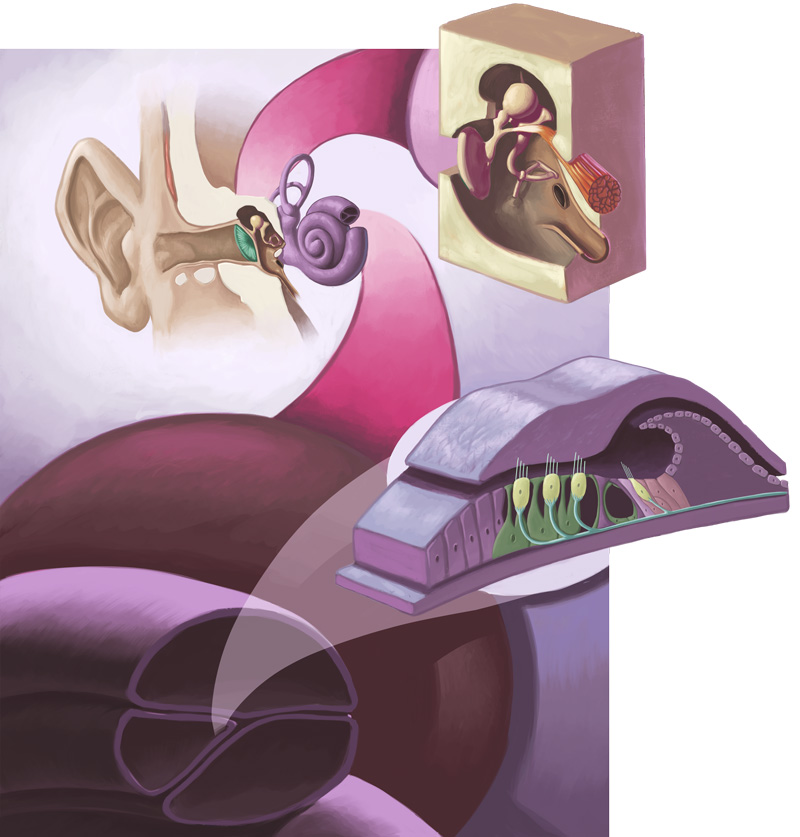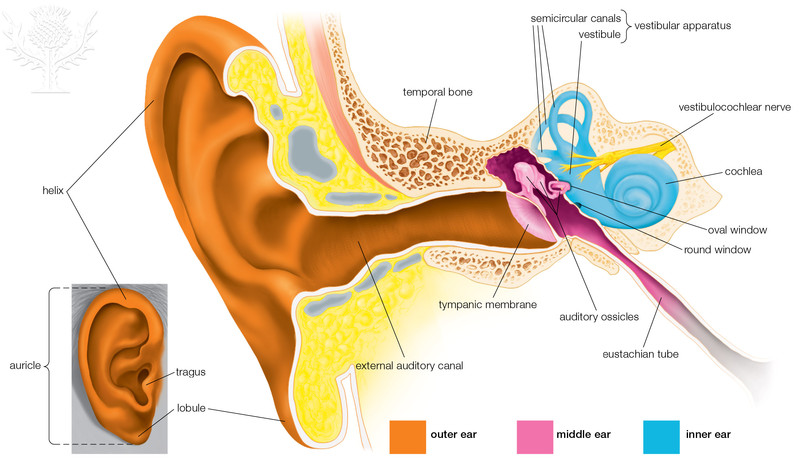Special Senses
THE NATURE OF SOUND
The ear is a sensory organ designed to capture, transmit and translate sound waves into action potentials. Before we can understand how this is done we need to have a working knowledge of what sound waves are. Sound waves are pressure waves with alternating regions of compressed air and non-compressed (rarefied) atoms. Typically these waves occur in air, but they can also occur in other media such as fluids, and even solids. We will focus on the sound waves in the air since this is the usual means by which they enter our ears. We often depict sounds waves visually as an undulating line with the peak of the wave representing the compressed air and the valley the rarefied air. What we perceive as sound is a translation of the frequency and amplitude of the sound waves entering the ear. The frequency of sound is expressed as the number of peaks of the sound wave that pass a stationary point each second. Audible frequencies range from 20 Hertz (Hz) to 20,000 Hz (Hertz = cycles or peaks per second). Humans are most sensitive to sounds in the 1000-3000 Hz range. Our sense of hearing perceives different frequencies as different pitches. For example, low frequency sound waves are perceived as low-pitched sounds and high frequency sound waves are perceived as a high-pitched sounds. The amplitude of the sound wave is the degree of compression and rarefaction. Visually we would depict sounds of higher amplitude as greater undulations in our line. Perceptually, amplitude determines the loudness of the sound. The loudness of a sound is measured in decibels (dB). A whisper measures about 30 dB while normal conversation measures about 60 dB. The decibel scale is a log scale which means that for every 10 dB increase there is a 10-fold increase in intensity, hence normal conversation is about 1000 times louder than a whisper. Sounds that are too loud can damage the hearing apparatus and cause severe hearing loss. The pain threshold for sound is about 120 dB. The table below illustrates types of sounds associated with the decibel level and how long the unprotected ear can withstand the sound without being damaged.
|
Decibel Level |
Type |
Maximum time until damage without protection |
|
0 |
Quietest sound you can hear |
n/a |
|
30 |
Whisper |
n/a |
|
60 |
Normal conversations |
n/a |
|
90 |
Lawnmower, shop tools |
8 hours per day |
|
100 |
Chainsaw, snowmobile |
2 hours per day |
|
115 |
Sandblasting, rock concert |
15 minutes per day |
|
140 |
Gun blast, jet engine |
0 minutes per day |

BYUI image created by Isaak F15
The Hearing Apparatus
Anatomically the ear can be divided into three regions: the external ear, the middle ear, and the inner ear. As the structure of the ear is described try to follow along on the image below. The external ear consists of the auricle, or pinna and the external auditory canal. The auricle is designed to capture the sound waves and channel them into the auditory canal, which then conducts the sound waves to the tympanic membrane (ear drum). Within the auditory canal are ceruminous glands that secrete cerumen (ear wax). Cerumen acts as a lubricant, preventing the auditory canal from drying out, and it has some antibacterial properties to help prevent microorganism from growing in the ear. Additionally, along with the hairs that grow in the auditory canals the cerumen helps prevent foreign objects from entering the ear.
The tympanic membrane is the boundary between the external ear and the middle ear. Its primary function is to vibrate in response to the sound waves entering the ear. It is composed of a sheet of connective tissue covered on the outside by simple squamous epithelium and on the inside by simple cuboidal epithelium. The tympanic membrane is very sensitive and merely touching it with the end of a Q-tip can elicit sharp pain.
The middle ear is an air filled cavity between the outer ear and the inner ear. The most conspicuous components of the middle ear are the three auditory ossicles that form a bridge between the tympanic membrane and the oval window of the inner ear. These three bones are the malleus (hammer), the incus (anvil), and the stapes (stirrup). The malleus sits on the tympanic membrane and the stapes connects to the oval window while the incus sits between the two. The middle ear is connected to the back of the pharynx (back of the throat) by the Eustachian tube. The Eustachian tube allows the middle ear to equilibrate with the atmospheric pressure. If the pressure in the middle ear is different from atmospheric pressure it will either push or pull on the tympanic membrane resulting in discomfort or pain. The Eustachian tube is typically closed but can open briefly in response to yawing, swallowing or chewing. This is why chewing gum can help alleviate the pressure changes you feel in the ear when you drive over a mountain pass.
The inner ear is imbedded in the petrous portion of the temporal bone and consists of three structures, the vestibular apparatus, the semicircular canals, and the cochlea. It is composed of a network of tunnels in the bone collectively referred to as the bony labyrinth. Within the bony labyrinth are membranes that essentially line the tunnels. These membranes form the membranous labyrinth and contain the structures for generating action potentials. The vestibular apparatus and semicircular canals are involved with equilibrium and balance while the cochlea is involved with hearing.

© 2013 Encyclopædia Britannica, Inc. Downloaded from Image Quest Britannica; BYU-Idaho.
**You may use the buttons below to go to the next or previous reading in this Module**


